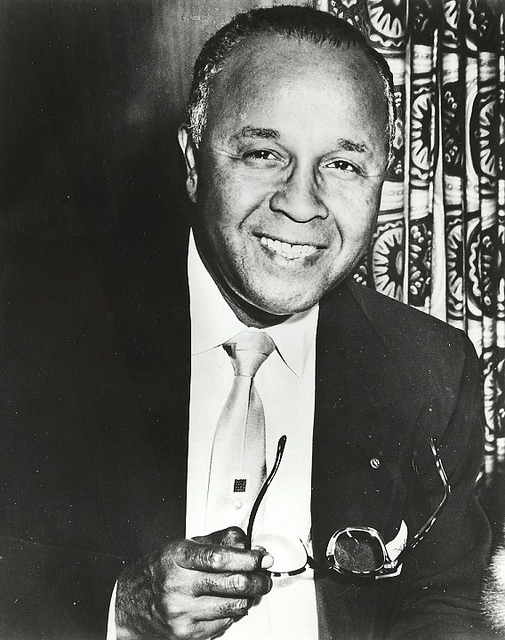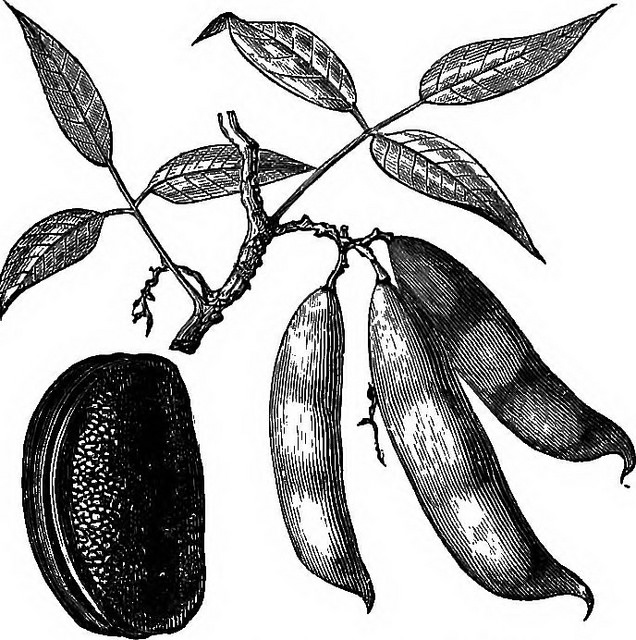Percy Lavon Julian was born in 1899 in Montgomery, Alabama. He would grow up to change the history of medicine and US agriculture through his discoveries in natural products chemistry. He also managed to get rich doing it. He was a gifted teacher and speaker. He engaged undergraduates in productive (i.e. published) research, hired a diverse team of scientists as a research director, and contributed to science both basic and applied. I wrote about Wilbur Scoville a few weeks ago, and Julian’s accomplishments really do dwarf Scoville’s.

This sounds like a standard American Dream coming true story, and it is, but the road there was a long one for Dr. Julian. Walking in the woods when he was a kid, he came upon a recently lynched man. Perhaps the most visceral experience of his early life, but almost certainly not the only lynching he heard/knew about. He grew up in the Jim Crow era South. He was discriminated against his entire life, with one brief respite while he was completing his Ph.D. in Vienna from 1929-31.
His grandparents had been slaves. His parents were educated, his mother a schoolteacher and his father a railroad mail clerk. They valued knowledge and saw education as a path to advancement. And the Julian family story bears that out though it wasn’t as if education was an inoculation against discrimination, but it provided opportunity. Julian’s parents invested in creating a small library for their kids with the goal of sending them all to college.
Julian was admitted to DePauw University in Indiana in 1916. Getting settled there was rough, to say the least. The university did not allow non-white people to live on campus and a room had to be found for him off-campus. He then had to spend a day and a half finding a diner that would serve him food. His living situation was far from stable (again, discrimination) until he struck a deal with the Sigma Chi fraternity who gave him room and board in exchange for him being their furnace stoker and household task-person.
His grandparents had been slaves. His parents were educated, his mother a schoolteacher and his father a railroad mail clerk. They valued knowledge and saw education as a path to advancement. And the Julian family story bears that out though it wasn’t as if education was an inoculation against discrimination, but it provided opportunity. Julian’s parents invested in creating a small library for their kids with the goal of sending them all to college.
He also found an encouraging mentor in the chemistry department: William Blanchard. Julian graduated Phi-Beta Kappa with a BS chemistry from DePauw, from a starting point of having to take some make-up high school classes on top of his college coursework. He moved on to become an instructor at Fisk University, then a Master’s degree at Harvard, but he was denied a teaching fellowship there, a requirement to earn a Ph.D. Again, discrimination.
He eventually got a teaching appointment at historically Black College Howard University in Washington, DC. From there, he got a fellowship to do research in Austria at the University of Vienna in the lab of Ernst Späth, doing natural products chemistry. Not only did Julian do good work in the lab (he even brought some lab supplies from the US new to the Viennese colleagues), he also found Vienna a lot more free of the outright discrimination he faced in the United States. For once, he was able to attend operas, plays, go out dancing, and otherwise act like a single person in their early 30’s. It was a social life devoid of pervasive discrimination. I’m not sure how Julian felt, but at the very least he saw that it was possible to live in a world with a lot less bias and racism.
In Späth’s lab, he focused on the calabar bean and an alkaloid (a common class of plant chemicals), physostigmine.
The goal of natural products chemistry was to find natural products (often plants) in nature that had biological activity and then try to isolate the chemicals responsible for that activity. Chemicals like caffeine in coffee beans. There’s a lot more than caffeine in coffee, but the biologically active component is caffeine, that has a specific chemical structure that interacts with our brain cells.

It was discovered that Calabar bean could act as eye medicine to treat glaucoma (somehow…), and physostigmine is also responsible for this medicinal effect (I’m not sure it’s used in this capacity any more, at least in the US). Percy Julian worked on the chemical contents of the bean, specifically the structure of physostigmine and its subsequent artificial synthesis.
Julian successfully determined the structure of physostigmine for his Ph.D. and when he went back to the United States, back to Howard, where due to university politics, bias, and the release of letters he sent back to colleagues from Vienna, he was left out of a job, but his old mentor William Blanchard hired him back at DePauw as a teaching assistant. Julian then focused his research, along with an Austrian colleague, the wonderfully named Josef Pikl on the artificial synthesis of physostigmine (also engaging undergraduate researchers in the effort). They were competing with a well-established lab at Oxford, who actually published first, but Julian noticed an error in their work– the melting temperature was a lot higher than it should have been for physostigmine. And in their paper, Julian and Pikl noted that the English group’s error. This gave Julian some notoriety and people did take note. And yet he could not find employment in academia. He almost got a job at Dupont, along with Pikl, but Dupont had not been aware Julian was black and denied him a position because of it. Pikl did take the Dupont job with Julian’s blessing and spent the rest of his career there.
Julian did get hired by a company in Appleton, Wisconsin only to learn that the town had a law: no African Americans could stay overnight. So even if the company wanted to hire him, he couldn’t live where he worked (and commuting was a lot bigger of a deal back then).
He eventually landed a job at Glidden, primarily a paint company, but a company heavily into chemistry. Julian was made the director of research and this is when his work on soy beans (Glycine max) started in earnest. He isolated protein from soy that was used in many things. Soy was still relatively new as a crop, but it is now the number 2 crop grown in the US, after maize. The reason for that is partly the work Julian did in natural products chemistry, using soybeans as a source of bulk steroids that could then be modified for producing human steroids with synthetic chemistry.

The soybean source provided scale to their production and Julian worked on scaling production after the initial synthetic steps were known (scaling is not always trivial). This led to widely accessible birth control pills, cortisone for arthritis, and many other steroids. To figure out the final cortisone synthesis, it was an early example of an industrial use of microbes to do the final conversion, synthetic chemistry through a fungus. Something that is commonly done now. After all, nature has a lot of enzymes that do very specific jobs that are a lot more efficient than doing the synthesis via traditional chemistry in a test tube. The way Julian initially figured out that soybean could be a source of steroids was that a batch of soybean oil, 100,000 gallons, got water in it, and a white precipitate formed at the bottom of the tank. Based on a previous observation when he was at DePauw, he realized that the precipitate contained plant steroid molecules and that isolating them would be straightforward. Glidden entered the steroid business– it was one more application of a natural product (besides protein, feed, and more).
There’s a lot more to Julian’s story– including more discrimination when the Julians moved into Chicago’s Oak Park neighborhood (there were those that supported the Julians too). Their house was bombed before they moved in, and after they moved in, Julian would spend nights in a tree in their yard with a shotgun (his son often joined him. Julian was so occupied at work (focused? obsessed? busy?) that he wasn’t around a lot. His wife, Anne Roselle Johnson, a Ph.D. herself, seems to have taken on a lot of the parenting. I couldn’t find out a lot about her, but likely she faced at least as much discrimination, if not more than Julian did.
Just remember if you spark something in someone that inspires them to learn, you may be making a difference not just for them, but for their kids, and their kid’s kids.
There’s a PBS documentary I’m using as the main source “Percy Julian: Forgotten Genius“, is available on Youtube, I recommend watching it. For a more condensed and humorous version of the story, Drunk History also took on the story of Percy Julian (Seeing Jordan Peele lip sync the drunken science lingo is pretty great). Next time you take or apply a steroid, or notice a soy bean product, Percy Julian had a hand in creating our modern world. Though he faced discrimination at every turn, he had enough people believing in what he could do to succeed. He did a lot for himself too. He did, at least, some basic, curiosity based research in an industry lab, something that may not be as common now, and did cause some clashes with his employer. Education mattered to the Julian family. In the Nova documentary, they interviewed Percy Julian’s granddaughter who is an MD. A belief in the power of education lasted from the son and daughter of slaves all the way to now. That might be one of the best things about Julian’s story. Education really did make a huge difference across generations for their family. Just remember if you spark something in someone that inspires them to learn, you may be making a difference not just for them, but for their kids, and their kid’s kids.
Sources:
Nova: “Pecy Julian: Forgotten Genius”
“Wicked Plants” by Amy Stewart.
4 thoughts on “Percy Julian, Natural Products Chemist.”